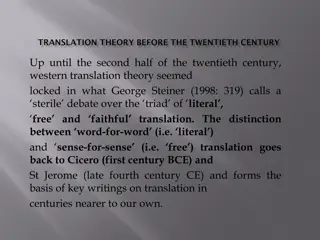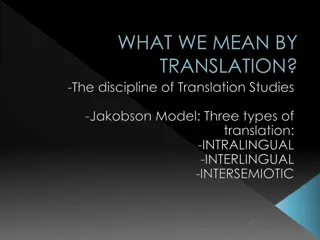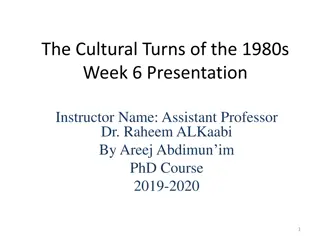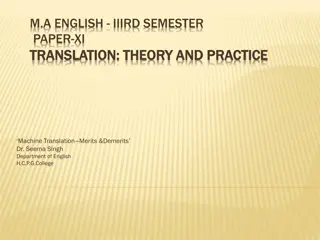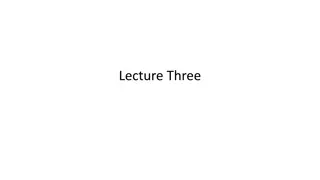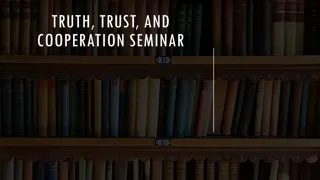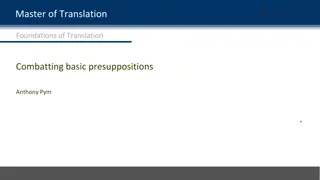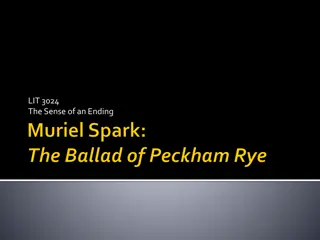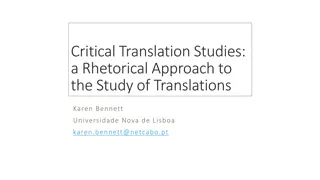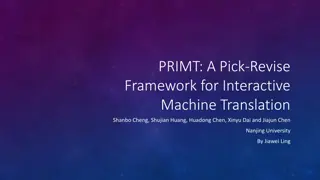
Principles and Methods of Language Teaching
Explore the origins, principles, and characteristics of the Grammar-Translation Method in language teaching. Learn about the traditional roles in the classroom, student interactions, and the emphasis on reading and writing skills. Discover how literary language, culture, and language skills are viewed in this method.
Download Presentation

Please find below an Image/Link to download the presentation.
The content on the website is provided AS IS for your information and personal use only. It may not be sold, licensed, or shared on other websites without obtaining consent from the author. If you encounter any issues during the download, it is possible that the publisher has removed the file from their server.
You are allowed to download the files provided on this website for personal or commercial use, subject to the condition that they are used lawfully. All files are the property of their respective owners.
The content on the website is provided AS IS for your information and personal use only. It may not be sold, licensed, or shared on other websites without obtaining consent from the author.
E N D
Presentation Transcript
"The Yellow Wall-Paper by Charlotte Perkins Stetson
Exercise 1 It is very seldom that mere ordinary people like John and myself secure ancestral halls for the summer. John is a physician, and perhaps (I would not say it to a living soul, of course, but this is dead paper and a great relief to my mind - ) perhaps that is one reason I do not get well faster. It is a big, airy room, the whole floor nearly, with windows that look all ways, and air and sunshine galore. I think sometimes that if I were only well enough to write a little it would relieve the press of ideas and rest me. I don t feel as if it was worth while to turn my hand over for anything, and I m getting dreadfully fretful and querulous.
Exercise 2 immovable fatuity earnest subtlest waddling derision astonish puzzling
The Grammar- Translation Method Alexandra Gunz and Muriel Fritschi Fachdidaktik I Englisch Hansj rg Perino
Origin Not a new method Was called the Classical Method Was first used in the teaching of the classical languages Was used earlier in the 20th century for the purpose of helping students to read and appreciate foreign language literature Was hoped that this method helps students to speak and write their native language better It was thought that this method helps students to grow intellectually
Principles Goals: students are able to read literature written in the target language Roles: traditional, the teacher is the authority in the classroom
Principles Characteristics Students are taught to translate from one language into another one They translate readings in the target language Students study grammar deductively They learn grammatical paradigms (e.g. verb conjugations) They memorize native language equivalents for target language vocabulary words
Principles Interaction: Mostly from teacher to the students View on Language and Culture Literary language is considered superior to spoken language Culture is viewed as consisting of literature and the fine arts Areas of Language Vocabulary and grammar are emphasized Reading and writing are the primary skills Less attention given to speaking, listening and pronunciation
Principles Student s native language Language used mostly in class Evaluation Written test in which students are asked to translate from their native language into the target language or vice versa Questions about the target culture Application of grammar rules Response to students errors Having students get the correct answer is considered very important
Techniques Translation of a Literary Passage Including grammar rules and vocabulary The translation may be written or spoken or both Reading Comprehension Questions Information contained within the reading passage Making inferences Relate a passage to students own experience Antonyms and Synonyms Find antonyms, synonyms, other vocabulary exercises
Techniques Cognates Students are taught to recognize cognates Students are asked to memorize words that look like cognates but have differing meanings in the target language Deductive Application of Rules Grammar rules are presented with examples Fill-in-the-blanks Exercise Vocabulary, grammar
Techniques Memorization Vocabulary, grammatical rules, grammatical paradigms Use Words in Sentences Students make up new sentences to show that they have understood the meaning and use of new vocabulary Composition Students write about a topic in the target language





